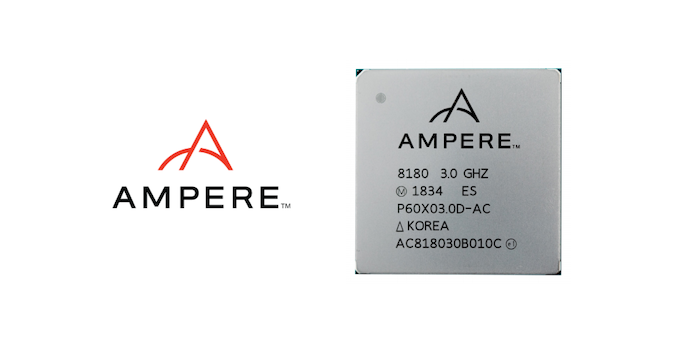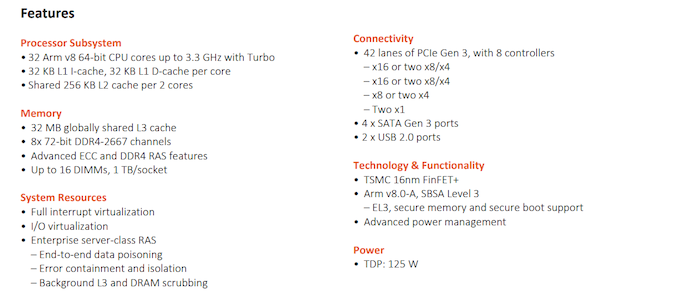Ampere Computing: Arm is Now an Investor
by Ian Cutress on April 15, 2019 11:15 AM EST
The pipeline for Arm based server products has a few companies fighting for as much of the market as they can get – the server market is a big pie to consume, and not only do these companies have to tempt customers from x86, but they also have to compete with each other to get customers. Most of them do this by having highly focused and niche products, targeted to a few key select markets. Ampere is one of those companies, using the old AppliedMicro IP, and now the company has a solid presence in its investor lineup: Arm.
Ampere, founded by former Intel president Renée James and funded by the Carlyle Group, currently offers its eMAG range of processors since October 2018. The company purchased AppliedMicro’s X-Gene Arm-based server assets back in early 2018, and offers a custom Arm v8.0-A chip design with 32 cores running at 3.3 GHz, built on TSMC’s 16FF+ process. The chip is based on the X-Gene II platform with optimizations, and the company has a roadmap planned for the next few years with updated generations of its eMAG product line. Recent product wins with eMAG include publicly available cloud instances from Packet, running at $1/hour.
One of the aspects of these server companies using the Arm architecture is getting their elbows out into the market and selling at volume. At present, only Cavium has succeeded with its ThunderX2 platform, finding its way into servers, cloud instances, and even HPC deployments. These companies rely on rounds of investment early on in the design cycle, both in terms of money to develop products but also with respect to expertise that potential investors can bring. Ampere is part of The Carlyle Group, which has a large portfolio of investment, however the most recent round of investment into Ampere brings Arm under that list as well.
With Arm as an investor, it will be interesting to see how much the companies will want to interact beyond the raw cash injection. Arm doesn’t invest in every Arm server chip company on the market, but the relationship has the potential to give Ampere some insight into Arm’s future design portfolio (perhaps more than previously) as well as opportunities to focus resources, drive down development costs, or enhance final products. Depending on the level of interaction, this could give Ampere an advantage, especially in front of customers, compared to Arm’s other licensees that also play in this space.
This was the second round of investment for Ampere. It was not disclosed how much investment was made, nor the valuation, or how much each investor has contributed.
“This significant investment from Arm and our initial investors signals their confidence in the future of Ampere and allows us to continue to accelerate and deliver our robust roadmap,” said Renee James, Ampere founder, CEO and Chair. The company announced its first product, eMAG™, in October 2018.
“A robust ecosystem is critical to advance the Arm® architecture as the foundation for transforming the modern cloud to edge infrastructure,” said Rene Haas, president Arm IP Products Group. “Investing in Ampere underscores Arm’s commitment to accelerating both our ecosystem and availability of diverse Arm-based silicon solutions for an infrastructure market long deprived of choice and flexibility.”
Related Reading
- Ampere eMAG in the Cloud: 32 Arm Core Instance for $1/hr
- Arm Announces Neoverse N1 & E1 Platforms & CPUs: Enabling A Huge Jump In Infrastructure Performance
- Arm Announces Neoverse Infrastructure IP Branding & Future Roadmap
Source: Ampere











12 Comments
View All Comments
SydneyBlue120d - Monday, April 15, 2019 - link
Who will be the first one with a Armv8.5-A processor?name99 - Tuesday, April 16, 2019 - link
Apple. Just like they were first with ARMv8.2 and 8.3.The INTERESTING question is whether they will be first with SVE (optional part of ARMv8.2)
(Yeah, yeah Fujitsu has ANNOUNCED SVE support. But when do they SHIP anything? Before October 2019?)
Mikewind Dale - Monday, April 15, 2019 - link
I want to see how much one of these servers costs. The 32 core eMag CPU is supposed to cost about $850, which is half what a ThreadRipper 2990WX costs ($1699.99). I know it's not intended as a workstation, but I wonder if it might be suitable as one anyway. If the price of the server is proportional to the price of the CPU, then this could be a very good deal.(I do statistical regression analysis, which is basically a lot of matrix algebra. So it's highly parallelizable, and core count can matter more than IPC or clock speed.)
ats - Monday, April 15, 2019 - link
There is basically no relation between CPU cost and server cost. And generally it is cheaper to get an AMD or Intel server than any ARM server. While the list price difference for the CPU may favor the eMag, the actual motherboard/server cost is the same or higher if you can even find someone to sell you one. Even AMD has orders of magnitude higher volume than Ampere does in the server space and NRE has a massive factor in cost in this space.Wilco1 - Monday, April 15, 2019 - link
You can get a 32 core eMAG CPU with motherboard for just £1800 [1]. You can't buy a 32 core Xeon CPU that cheap! Eg. Xeon Gold 6134 with only 8 cores goes for £1645 [2].So you may need to reevaluate your misconceptions a bit.
[1] https://store.avantek.co.uk/ampere-emag-64bit-arm-...
[2] https://www.lamicro.co.uk/intel-xeon-gold-6134-cpu...
ats - Monday, April 15, 2019 - link
You are proving my point. $1k for a UP motherboard, wtf!Wilco1 - Monday, April 15, 2019 - link
That's a complete system price including case and power supply. And you need to compare with a dual Xeon to get a similar core count. The cheapest 2P Xeon boards go for around £400-500, then add the case and power supply. You simply have no point.rahvin - Tuesday, April 16, 2019 - link
The core count is an irrelevant comparison if each core is doing 1/4 the work of the core you are trying to compare it to. In the server market the comparison used is typically performance/$ or performance/watt on the workload that the owner anticipates. The ThunderX2 has rotten performance in comparison to the x86 cores. It does excel at a few specific workloads (like an HTTP master server in a cluster where it's high thread count and low performance per thread is an advantage) but as a general server CPU you can't do a core-core comparison.In the traditional server workloads the ARM server chips that have been brought to market have not done well and their limited deployments often keep costs well above the x86 competition making the numbers even worse.
Don't get me wrong, I'd love to see a competative ARM server core, it would help drive costs down in the market for everyone but right now such a product just doesn't exist. The ARM server cores that have been brought to market have a few viable market segments but they are only good in very specific workloads. Until that changes and ARM or it's partners brings a server chip to market that can compete as a general server CPU ARM is a non-factor in the server market.
Jackm-tech - Wednesday, July 10, 2019 - link
Whereas Wilco1 does have a fair point, you're using a fairly over priced component to backup your point! You can find 20-Core Gold CPUs for <£2,000 each, just need to use a better supplier! EG;https://www.bargainhardware.co.uk/sr3b6-intel-xeon...
You will find that these CPUs will start coming down when they hit the 3 y/o mark due to system recycling cycles.
mode_13h - Tuesday, December 24, 2019 - link
Shopping used might make sense for an individual with lower reliability or efficiency requirements, but it's not very informative in this context.BTW, there are reasons why data centers don't want that hardware, any more.